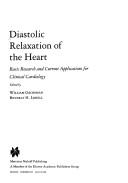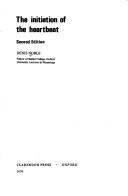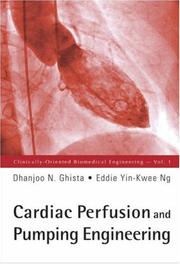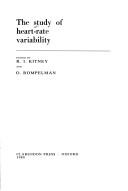| Listing 1 - 10 of 13 | << page >> |
Sort by
|
Book
ISBN: 1281928259 9786611928254 9812775595 Year: 2007 Volume: v. 1 Publisher: Hackensack, NJ : World Scientific,
Abstract | Keywords | Export | Availability | Bookmark
 Loading...
Loading...Choose an application
- Reference Manager
- EndNote
- RefWorks (Direct export to RefWorks)
For the first time, this invaluable book shows how cardiac perfusion and pumping can be quantified and correlated. Self-contained and unified in presentation, the explanations in the compendium are detailed enough to capture the reader's curiosity and complete enough to provide the background material to explore further into the subject.Mathematically rigorous and clinically oriented, the book is a major resource for biomedical engineers, cardiologists, cardiac surgeons and clinicians. For students, it is an ideal textbook for senior-level courses in cardiovascular engineering.
Diastole (Cardiac cycle) --- Heart --- Perfusion (Physiology) --- Contraction.

ISBN: 0898389518 9780898389517 Year: 1988 Publisher: Boston: Nijhoff,
Abstract | Keywords | Export | Availability | Bookmark
 Loading...
Loading...Choose an application
- Reference Manager
- EndNote
- RefWorks (Direct export to RefWorks)
Diastole (Cardiac cycle) --- Congestive heart failure --- Myocardial Contraction
Multi
ISBN: 9781437711004 1437711006 9781416037545 1416037543 Year: 2008 Publisher: Philadelphia : Saunders/Elsevier,
Abstract | Keywords | Export | Availability | Bookmark
 Loading...
Loading...Choose an application
- Reference Manager
- EndNote
- RefWorks (Direct export to RefWorks)
This reference thoroughly equips you to successfully diagnose and manage even the most complex incidences of diastolic heart failure and their comorbidities. It examines the basic mechanisms of this condition through discussions of both cellular and anatomic causes; guides you through non-invasive techniques for diagnosis, including echocardiography, cardiac CT, and MRI; and provides expert advice on pharmacologic management.Covers the basic mechanisms of diastolic heart problems from both cellular and anatomic perspectives. Chapters covering modalities helpful in assessment
Congestive heart failure. --- Heart --- Diastole (Cardiac cycle) --- Left ventricle --- Pathophysiology.
Book
ISBN: 1437711006 1416037543 1336234806 9781437711004 9781416037545 Year: 2008 Publisher: Philadelphia Saunders/Elsevier
Abstract | Keywords | Export | Availability | Bookmark
 Loading...
Loading...Choose an application
- Reference Manager
- EndNote
- RefWorks (Direct export to RefWorks)
This reference thoroughly equips you to successfully diagnose and manage even the most complex incidences of diastolic heart failure and their comorbidities. It examines the basic mechanisms of this condition through discussions of both cellular and anatomic causes; guides you through non-invasive techniques for diagnosis, including echocardiography, cardiac CT, and MRI; and provides expert advice on pharmacologic management.Covers the basic mechanisms of diastolic heart problems from both cellular and anatomic perspectives. Chapters covering modalities helpful in assessment
Congestive heart failure. --- Heart --- Diastole (Cardiac cycle) --- Left ventricle --- Pathophysiology. --- Relaxation, Diastolic (Cardiac cycle) --- Heart beat --- Cardiopulmonary system --- Cardiovascular system --- Chest --- Heart failure --- Diastolic relaxation --- Relaxation, Diastolic

ISBN: 019857178X Year: 1979 Publisher: Oxford Clarendon
Abstract | Keywords | Export | Availability | Bookmark
 Loading...
Loading...Choose an application
- Reference Manager
- EndNote
- RefWorks (Direct export to RefWorks)
Action potentials (Electrophysiology) --- Heart beat --- Heart --- Electrophysiology --- Cardiac cycle --- Cycle, Cardiac --- Heart cycle --- Heart rate --- Heart conduction system --- Hemodynamics --- Pulse --- physiology --- Contraction --- Blood physiology. Circulatory physiology

ISBN: 9789812706966 Year: 2007 Publisher: New Jersey : World scientific,
Abstract | Keywords | Export | Availability | Bookmark
 Loading...
Loading...Choose an application
- Reference Manager
- EndNote
- RefWorks (Direct export to RefWorks)
Coronary Circulation. --- Diastole (Cardiac cycle). --- Heart --- Heart --- Heart-Assist Devices. --- Models, Biological. --- Myocardial Contraction. --- Perfusion (Physiology). --- Ventricular Function, Left --- Contraction. --- Physiology. --- Physiology.
Book
ISBN: 1447143086 1306162017 1447143094 Year: 2014 Publisher: London : Springer London : Imprint: Springer,
Abstract | Keywords | Export | Availability | Bookmark
 Loading...
Loading...Choose an application
- Reference Manager
- EndNote
- RefWorks (Direct export to RefWorks)
This book is an evaluation of heart rate variability (HRV), the tendency for the heart rate to oscillate, increasing and decreasing depending on a number of factors. Such oscillations can give information on the state of the complex systems involved and can reveal a higher mortality risk. The author discusses the basic functional structures responsible for HRV and the evidence for this. In addition, the book provides a framework to understand HRV within the perspective of systems biology and presents basic principles and related mathematical models. Heart Rate Variability provides a thorough investigation of the clinical aspects of the concept, defining the level of risk, the practical management algorithms and clarification of the common mechanisms, such as heart rate turbulence. As such, this book will be of interest to all involved in the research and management of all the cardiovascular conditions related to this phenomenon.
Heart beat. --- Arrhythmia. --- Allorhythmia --- Arhythmia --- Arrhythmias --- Cardiac arrhythmia --- Dysrhythmia --- Irregular heart beats --- Cardiac cycle --- Cycle, Cardiac --- Heart cycle --- Heart rate --- Medicine. --- Cardiology. --- Medicine & Public Health. --- Heart --- Heart beat --- Electric countershock --- Palpitation --- Heart conduction system --- Hemodynamics --- Pulse --- Diseases --- Contraction --- Internal medicine
Book
ISBN: 9781400869114 1400869110 9780691601199 9780691081977 Year: 2015 Publisher: Princeton, NJ
Abstract | Keywords | Export | Availability | Bookmark
 Loading...
Loading...Choose an application
- Reference Manager
- EndNote
- RefWorks (Direct export to RefWorks)
Despite great ferment and activity among historians of science in recent years, the history of physiology after 1850 has received little attention. Gerald Geison makes an important contribution to our knowledge of this neglected area by investigating the achievements of English physiologists at the Cambridge School from 1870 to 1900. He describes individual scientists, their research, the scientific issues affecting their work, and socio-institutional influences on the group. He pays special attention to the personality and contributions of Michael Foster, founding father of the Cambridge School. Foster's specific research interest was the origin of the rhythmic heartbeat, and the author contends that the school itself descended from and developed around this concern.Originally published in 1978.The Princeton Legacy Library uses the latest print-on-demand technology to again make available previously out-of-print books from the distinguished backlist of Princeton University Press. These editions preserve the original texts of these important books while presenting them in durable paperback and hardcover editions. The goal of the Princeton Legacy Library is to vastly increase access to the rich scholarly heritage found in the thousands of books published by Princeton University Press since its founding in 1905.
Heart beat --- Physiology --- Physiologists --- Biologists --- Medical scientists --- Animal physiology --- Animals --- Biology --- Anatomy --- Cardiac cycle --- Cycle, Cardiac --- Heart cycle --- Heart rate --- Heart --- Heart conduction system --- Hemodynamics --- Pulse --- History. --- Biography. --- Contraction --- Foster, M.
Book
ISBN: 1461473748 1489988432 1461473756 Year: 2013 Publisher: New York : Springer Science,
Abstract | Keywords | Export | Availability | Bookmark
 Loading...
Loading...Choose an application
- Reference Manager
- EndNote
- RefWorks (Direct export to RefWorks)
The Poincaré plot (named after Henri Poincaré) is a popular two-dimensional visualization tool for dynamic systems due to its intuitive display of the dynamic properties of a system from a time series. This book presents the basis of Poincaré plot and focus especially on traditional and new methods for analysing the geometry, temporal and spatial dynamics disclosed by the Poincaré plot to evaluate heart rate variability (HRV). Mathematical descriptors of Poincaré plot have been developed to quantify the autonomic nervous system activity (sympathetic and parasympathetic modulation of heart rate). Poincaré plot analysis has also been used in various clinical diagnostic settings like diabetes, chronic heart failure, chronic renal failure and sleep apnea syndrome. The primary aims of quantification of the Poincaré plots are to discriminate healthy physiological systems from pathological conditions and to classify the stage of a disease. The HRV analysis by Poincaré plot has opened up ample opportunities for important clinical and research applications. Therefore, the present book can be used either for self-study, as a supplement to courses in linear and nonlinear systems, or as a modern monograph by researchers in this field of HRV analysis.
Biomedical engineering. --- Cardiology. --- Heart -- Pathophysiology. --- Heart beat. --- Heart Rate. --- Heart. --- Medicine. --- Pulse. --- Medicine --- Health & Biological Sciences --- Cardiovascular Diseases --- Heart rate monitoring. --- Heart beat --- Mathematical models. --- Cardiac cycle --- Cycle, Cardiac --- Heart cycle --- Heart rate --- Medicine & Public Health. --- Biomedical Engineering. --- Heart --- Heart conduction system --- Hemodynamics --- Pulse --- Cardiography --- Patient monitoring --- Contraction --- Biomedical Engineering and Bioengineering. --- Clinical engineering --- Medical engineering --- Bioengineering --- Biophysics --- Engineering --- Internal medicine --- Diseases --- Diagnosis.

Abstract | Keywords | Export | Availability | Bookmark
 Loading...
Loading...Choose an application
- Reference Manager
- EndNote
- RefWorks (Direct export to RefWorks)
Arrhythmia --- Heart beat --- Heart Rate --- 612 --- Cardiac cycle --- Cycle, Cardiac --- Heart cycle --- Heart rate --- Heart --- Heart conduction system --- Hemodynamics --- Pulse --- Allorhythmia --- Arhythmia --- Arrhythmias --- Cardiac arrhythmia --- Dysrhythmia --- Irregular heart beats --- Electric countershock --- Palpitation --- Cardiac Chronotropy --- Cardiac Rate --- Chronotropism, Cardiac --- Heart Rate Control --- Heartbeat --- Pulse Rate --- Cardiac Chronotropism --- Cardiac Rates --- Chronotropy, Cardiac --- Control, Heart Rate --- Heart Rates --- Heartbeats --- Pulse Rates --- Rate Control, Heart --- Rate, Cardiac --- Rate, Heart --- Rate, Pulse --- Heart Rate Determination --- Fysiologie --- Contraction --- Diseases --- Blood physiology. Circulatory physiology
| Listing 1 - 10 of 13 | << page >> |
Sort by
|

 Search
Search Feedback
Feedback About UniCat
About UniCat  Help
Help News
News